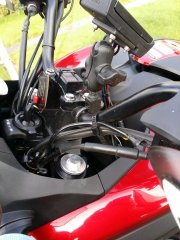I would check for sticky brake pistons , which my bike at least is prone to ,especially the front and always needs a thorough annual strip down and clean and much pushing in and out of the pistons before they really free up and double check there's no resting on the rear brake pedal . I ride mine pretty hard, and find avoiding hard braking into corners makes quite a difference to economy, but then I like hard braking as the bike brakes like a super bike . But its cost me a new rear brake disc at 54000 miles ,and probably the front too if it wasn't replaced with warranty at 24000 miles, and th


